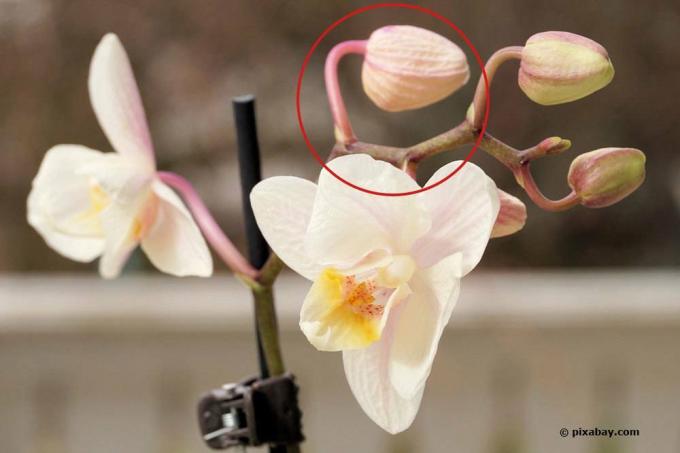
table of contents
- causes
- Location
- cold
- Heating air
- humidity
- Water
- light
- Substrate
- Ethylene
- Pests
With its flowers, the orchid in all its variations is a hit in German living rooms and is particularly popular with its eye-catching shape. Every year new buds form so that the Orchidaceae can present their bloom again. But it can happen that due to mistakes in care the buds dry up and then fall off. Without the buds, no flowers will be able to form, which should be avoided at all costs.
causes
Causes of the loss of buds
When orchids lose their buds, this usually indicates an error in the location or the climatic conditions at the location. Faults in maintenance are the cause less often, but this cannot be ruled out either. If you notice that the buds of the Orchidaceae are already beginning to dry up, you should definitely find the cause and take action. The following causes are typical for the drying up of the buds.
- Change of location
- cold drafts
- Heating air
- blazing midday sun
- too little light
- Lack of water
- low humidity
- wrong substrate
- Etyhlen
- Pests
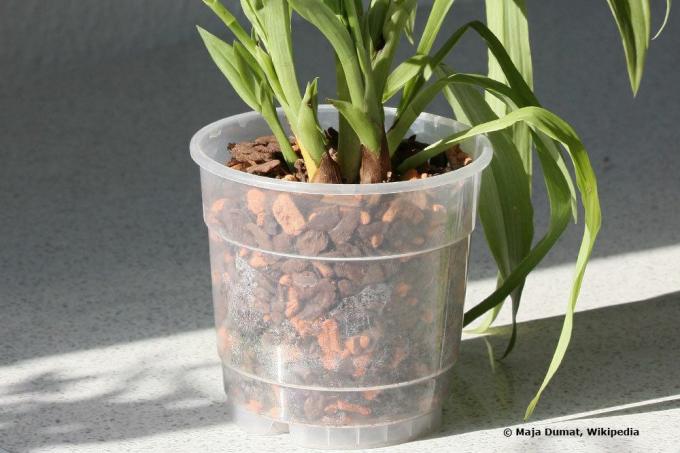
Location
Relocation can be harmful
Like many tropical plants, orchids are plants that are true to their location and do not want to get used to a new environment. If the location had to be changed for reasons of maintenance or other problems, you should make sure to provide a suitable location for the plant. This should best match the previous location or have the following characteristics.
- bright
- no direct sunlight
- Avoid temperature fluctuations
- Avoid drafts
This should help the orchid recover and then be able to bud again. However, since bud loss is often accompanied by failure of flowering, you shouldn't be surprised if flowers don't show up until the next season.
cold
Avoid cold shock from drafts
Cold is never good for an orchid. Kinds like Phalaenopsis come from the warm tropical regions with high humidity and can suffer badly from the winter cold if improperly kept. During the cold season, do not place your orchid near windows or doors that open frequently and let cold air into the room. The draft has an immediate effect on the sensitive roots, which are exposed in most of the species. The only thing that helps here is a change of location, away from drafts.
Note: If you buy an orchid in winter, please pay attention to the type of packaging in which you are transporting the plant home. If it is not extensively wrapped in newspaper or a cardboard box, it can lose all of its blooming splendor in just a few minutes in the winter cold.
Heating air
Also avoid warm heating air
Just as cold drafts are not ideal for orchid plants, warm heating air in the immediate vicinity of the orchid should also be avoided. This does not cause the shoots to die off, but the air is so dry and circulates so strongly in the room that the buds feel like they are in an oven. They dry out and then fall off the shoots. You can avoid these problems by keeping the plant away from a heater or, if possible, not turning it on for the winter.
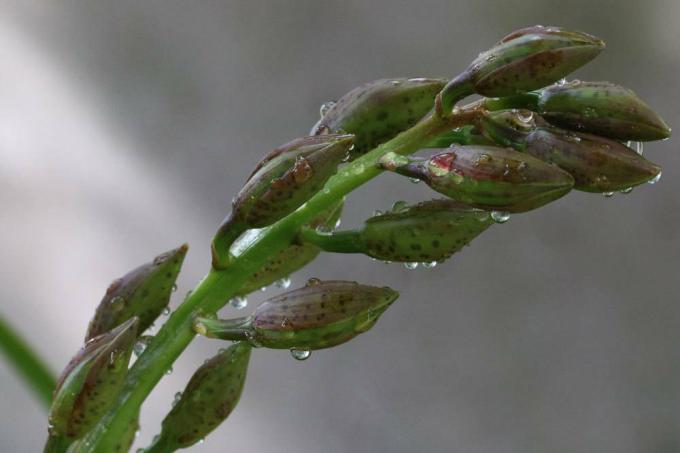
humidity
Humidity for sufficient water supply
Orchids absorb moisture from the air, even buds. It is therefore important, especially in winter, to guarantee a sufficiently high level of humidity, which should be between 50 and 60 percent. In winter this often falls below 40 percent, which is also uncomfortable for people and shows up in dry, cracked skin. The humidity can be increased by various measures, as shown below.
- Spray the plant daily with soft water (lime-free)
- Fill the bowls with water and place them on the heater
- use a humidifier
- Fill coasters with a mixture of water and expanded clay, which leads to permanent evaporation that increases the humidity in the immediate vicinity of the plant
Water
Avoid water shortages
The lack of water in orchids is shown by the silvery, shiny roots and the drying out of the leaves, buds and shoots. Since the lack of water is difficult to read from the substrate, you have to look especially at the roots. A lack of water can be compensated for very quickly. To do this, simply use an immersion bath and let the flower stay there for about 20 minutes. The amount of water required differs depending on the species, and for some varieties just spraying the leaves is sufficient.
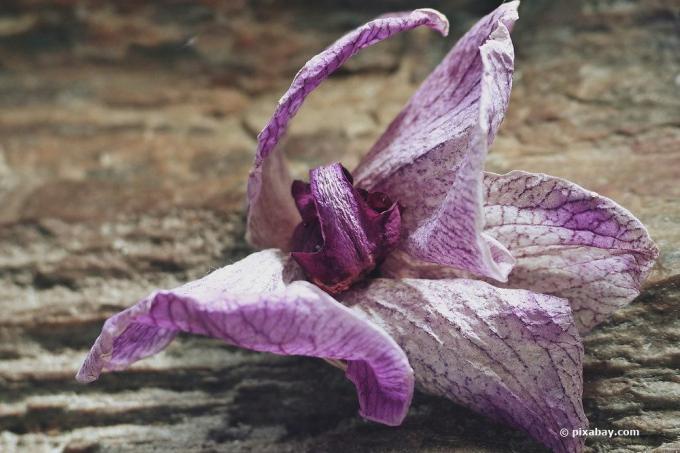
light
The right light is crucial
Species like Phalaenopsis depend on a good supply of light and there are two things to keep in mind.
- enough light
- no blazing sun over midday
The tropical plant needs a large amount of light and receives extra care in winter so that it does not suffer from a lack of light, which in itself should not be a problem in summer. If your orchid is too dark, it cannot carry out important metabolic processes and dies. The buds dry up first, followed by the leaves and shoots.
Compensate for a lack of light as follows:
- from March to October it is placed next to a window with a lot of sun
- During the winter time it is placed on the south window
- Place the LED plant lamp / daylight lamp over the orchid
- Fluorescent tubes can also be used
- increase the amount of light using suitable reflectors
In this way, the plant receives enough light over the winter to be able to carry out photosynthesis. In contrast, the blazing midday sun is a completely different problem. This creates a form of sunburn that the buds cannot tolerate and then die from the extreme amount of light. Here it is best to choose a shade to protect the orchid on the balcony, window sill or terrace from too much sun.
Substrate
The wrong substrate was chosen
For orchid newbies, the question of the right substrate is often confusing and initially leads to many bankruptcies. There are an extremely large number of orchid species on the market, the most common of which is the moth orchid. It prefers a loose orchid substrate and is often wrongly offered in pots with soil. Soil is used exclusively for the terrestrial orchids and can be fatal to epiphytic orchids that have open roots. When you buy an orchid, repot it immediately if it is in soil or in an unsuitable substrate for the variety in question.
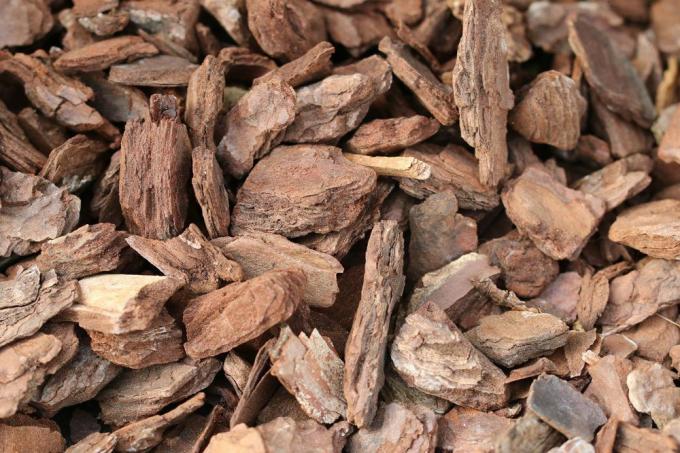
Ethylene
What is ethylene and why does it harm orchids?
Ethylene is a growth regulator of numerous plants, including many types of fruit such as apples, bananas, citrus fruits or potatoes and onions. This gas is produced by the appropriate species and is colorless and odorless. Due to the composition of ethylene, the orchid ripens faster and the buds dry up due to the aging process. This can be remedied quickly if you store the appropriate food at least one meter away from the orchid, because the gas does not reach that far. Fruit trees are also affected by this rule.
Pests
Fight pests
In the event of a pest infestation, the buds, shoots and leaves are particularly affected, as these are supplied with nutrients via plant sap. Pests such as spider mites, smear mites or aphids feed on these. If you find that your orchid is streaked with white webs, similar to cobwebs, isolate the plant to prevent the mites from spreading to other specimens. Then proceed as follows.
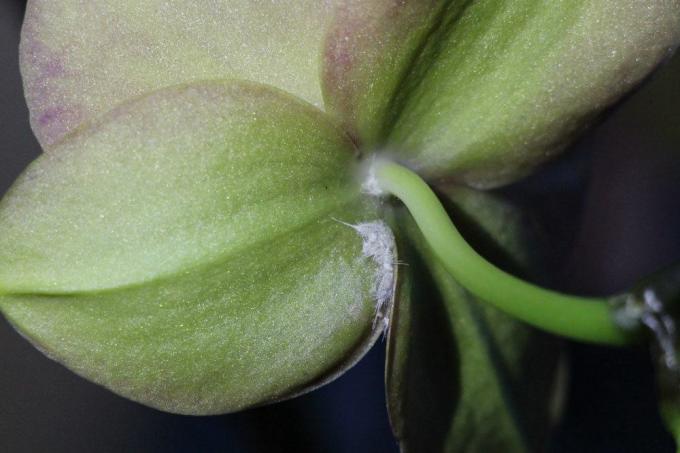
- wipe the plant thoroughly with a damp cloth to remove aphids
- spray the leaves and shoots with soft soap solution
- Cotton swabs that you soak in alcohol beforehand are effective against all types of mites; the swabs dab off pests
- treat the top and bottom of the leaves, this is the only way the buds can also recover
- Then rinse the plant thoroughly with water and repeat the process until no more infestation can be seen
Tip: Australian ladybirds (Cryptolaemus montrouzieri) are a perfect protection against mites and are available in specialty shops. These are released in a closed space including the orchid and take care of the pests.



